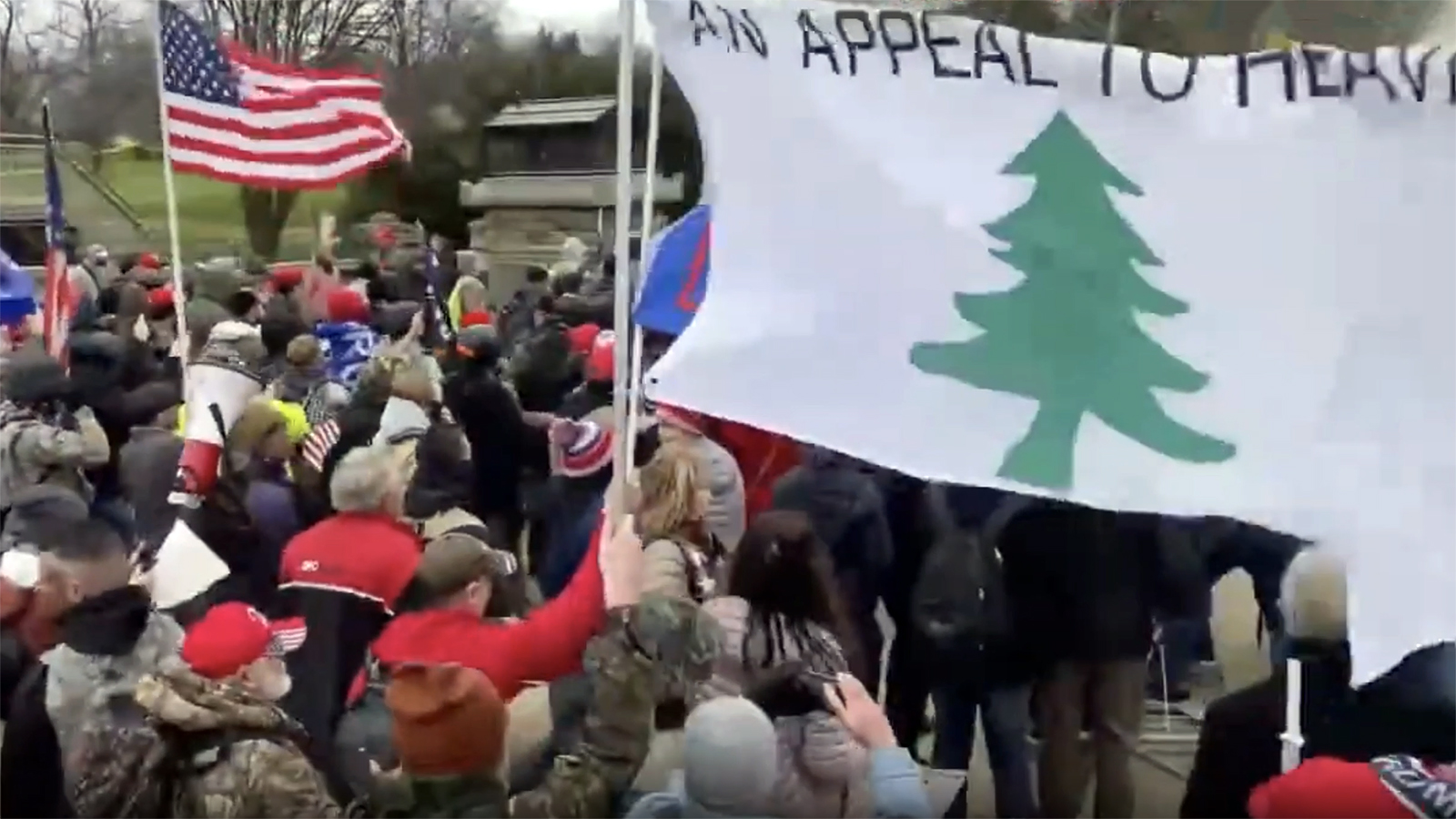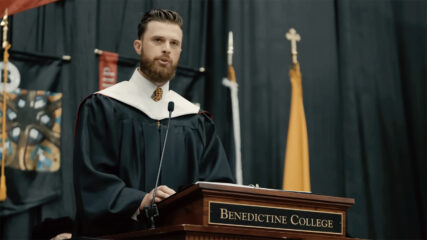
[ad_1]
(RNS) — Catholics are becoming some of Christian nationalism’s most muscular champions.
Most prominently, Republican vice presidential nominee J.D. Vance is a recent Catholic convert tied to Catholic integralism, an ideology that seeks Christian influence over society. As RNS’ Jack Jenkins has reported, although integralism differs from Christian nationalism on some points, it “shares many of the same policy goals as popular forms of Christian nationalism,” mainly for the government and its policies to be heavily influenced by Christian values. Vance’s recent elevation to the VP slot means this distinctively Catholic brand of Christian nationalism will have a larger platform than ever before.
Meanwhile, the Christian nationalist policy blueprint Project 2025 is making waves as Americans learn more about its contents. Less attention has been paid to the man behind Project 2025, Heritage Foundation President Kevin D. Roberts. Roberts is a proud “cowboy Catholic” who believes a “second American Revolution” is underway, which “will remain bloodless if the left allows it to be.” He made this comment as a guest on “The War Room,” a show hosted by the far-right strategist and Catholic Stephen K. Bannon, who recently reported to prison for contempt of Congress. Bannon is a “proud Christian nationalist,” and “The War Room” is fashioned as a virtual “military headquarters” for Bannon’s “Army of the Awakened.” Though Bannon describes being raised in a relatively conventional “blue-collar, Irish Catholic” family, later in life he turned toward an apocalyptic and conservative strain of the faith.
Earlier this summer, Supreme Court Justice Samuel Alito, a conservative Catholic who wrote the majority opinion in the 2022 case that overturned Roe v. Wade, came under fire when it was discovered that his wife had flown both an upside-down American flag and an “Appeal to Heaven” flag outside their homes in recent years. Both flags, and especially the latter, were immediately recognized as symbols of support for former President Donald Trump. Both flags were carried by Jan. 6 Capitol rioters. The Appeal to Heaven flag, originally used in the Revolution’s resistance to the British, resurfaced in recent years as a symbol of the movement to expand Christian influence in American government.
Shortly after, Alito was recorded by an activist posing as a fellow Catholic agreeing with the statement that “people in this country who believe in God have got to keep fighting for that — to return our country to a place of Godliness.” This confluence of revelations has led to increased scrutiny of the religious views of the six conservative justices on the court, all of whom are either practicing Catholics or were raised in the Catholic Church.

Kansas City Chiefs’ kicker Harrison Butker delivers the Benedictine College commencement address on May 11, 2024, in Atchison, Kan. (Video screen grab)
Outside of formal politics, a controversial late May commencement speech by professional football player Harrison Butker drew attention to the Trad Cath (Traditionalist Catholic) world in which misogynistic and homophobic views like his have found a rapt following. Trad Caths are not just politically conservative. As Lauren Horn Griffin, assistant professor of philosophy and religious studies at Louisiana State University, wrote at Religion Dispatches, “Trad Caths use Latin, Crusader imagery, and Catholic material culture to manufacture ideas of a once-great White Western civilization currently under threat.” In other words, they have developed a distinctively Catholic version of the Christian nationalist narrative.
The prominence of these Catholic Christian nationalists may come as a surprise to those who associate Christian nationalism with white evangelical Protestantism. And rightfully so. While two-thirds of white evangelical Protestants nationally support Christian nationalism, according to PRRI’s American Values Atlas, only 30% of white Catholics do. And of these, only 8% of white Catholics are considered Christian nationalism “adherents” (who express the greatest support for Christian nationalist ideas) compared to 30% of white evangelical Protestants.
To put these figures into perspective, white evangelical Protestants have the highest level of support for Christian nationalism among all religious groups, while white Catholics fall somewhere in the middle of the pack. But this should not suggest Catholics are necessarily moderate where Christian nationalism is concerned; rather, they are polarized, as they are on many other issues.
Though the Catholic Church has long been evenly divided between Democrats and Republicans, the conservative wing of the Catholic Church has been expanding in the U.S. An April Pew report shows that “the GOP now has a modest advantage among Catholics,” and among white Catholics, 60% identify as Republicans. While young liberals are leaving organized religion in high numbers, the Trad Cath movement is attracting a new generation of young conservatives. And new Catholic priests are almost exclusively drawn from the Church’s conservative ranks, with more than 80% of those ordained since 2020 describing themselves as “theologically ‘conservative/orthodox’ or ‘very conservative/orthodox.’”
But the emergence of a Catholic brand of Christian Nationalism does not just reflect the church’s rightward turn. It is also the product of much longer process through which Catholics were gradually folded into the “Christian” majority in America. This had not always been the case. Before Catholics were part of the Christian in-group, they had been prime villains in the Christian nationalist narrative, alongside Jewish and Black Americans, communists and the government elites who aided and abetted these enemies of the white Christian nation. When the Ku Klux Klan marched during the 1920s under banners declaring “America First: One God, One Country, One Flag,” they were referring exclusively to the God of white Anglo-Saxon Protestants, the sole group they considered “One Hundred Percent American.” Catholics were not only considered ethnic outsiders (due to their Italian and Irish origins); their allegiance to a foreign pope was also considered suspicious and threatening. Think of the Islamophobia facing Muslims in America today: This was generally how American Catholics were treated during the early 20th century.
But long before most Americans were using the term “Christian nationalism” to describe those who sought Christian dominion in American politics, conservative Catholics had been organizing to exert influence on law and society, with a particular focus on issues like abortion. It was this issue, in part, that brought conservative Catholics into a strategic alignment with white evangelical Protestants, paving the way for the formation of an ecumenical Christian right in the 1970s.
It was through this partnership that lingering Protestant biases against Catholics also faded, and Catholics were finally folded fully into the category of American “Christians.” This process had been in motion since the Cold War, when the country’s so-called “Judeo-Christian” heritage was viewed as a ballast against atheist Communism. Once the external threat of Communism faded, that same “Judeo-Christian” heritage was invoked by conservative Protestants and Catholics alike to rebut domestic efforts to secularize the country. By the 1980s, the process was complete — American Catholics were now “Christians,” and thus stood to benefit from the idea that America was a Christian nation.

Ruth Braunstein. (Courtesy photo)
American Catholics are politically diverse and do not speak in one voice where Christian nationalism is concerned. But the conservative wing of the Catholic Church appears to be producing a powerful cohort of elite Catholic Christian nationalists who, if Donald Trump wins in November, will be at the very epicenter of American power. It is worth considering how their distinctive history, theology and institutions will shape their vision of how to exert Christian dominion over American society.
(Ruth Braunstein is an associate professor of sociology at the University of Connecticut and the director of the Meanings of Democracy Lab. The views expressed in this commentary do not necessarily reflect those of Religion News Service.)
[ad_2]